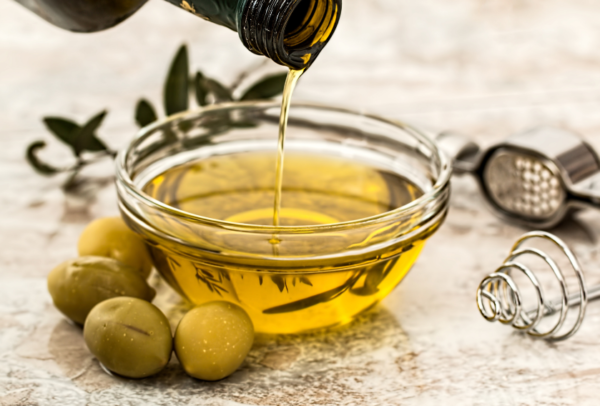Extra Virgin Olive Oil is known as culinary “Liquid Gold” for a reason.
If there is one ingredient that is central to a healthy, Mediterranean way of cooking, it is extra virgin olive oil. It’s no wonder! This “liquid gold”, as it is often referred to, is rich in antioxidants, vitamins E and K, and monounsaturated fatty acids that help protect against heart disease, stroke, and diabetes.
Most olive oil is produced in the Mediterranean region, especially in Italy, Spain, Greece, and Tunisia. California, Australia, and South America also produce olive oil. Four broad categories are used to classify olive oil – extra virgin, virgin, pure, and refined. Extra virgin olive oil is the least processed, richest tasting, and considered the highest quality.
Similar to wine, extra virgin olive oil’s color and flavor depend on the ripeness of the olives, the terroir in which they are grown, and the processing method used. Olive oil can range in color from gold to a shade of pale green. The flavors may be rich and robust with hints of olive and pepper, light and buttery, or more floral or grassy tasting. Many chefs and EVOO aficionados taste for fruitiness, bitterness, and pungency when considering how best to use a specific extra virgin olive oil. It’s a good habit to adopt! Make notes for yourself about the flavors of different brands and your preferences.
photo: Jenelle Botts Photography for Love + Craft Kitchen
WHY I LIKE COOKING WITH EXTRA VIRGIN OLIVE OIL
- HEALTH: EVOO is a healthy fat filled with nutrients to support good health and wellbeing.
- FLAVOR: It’s delicious on its own, and there are flavor variations depending on the season, type of olive, and where it is grown.
- VERSATILITY: It is a versatile and stable cooking oil – use it in vinaigrettes and marinades, for drizzling and dipping, and in cooking or baking.
- AVAILABILITY: Despite the American market being glutted with lesser quality cooking oils, good quality olive oils are becoming more readily available for home cooks. Retailers are realizing that customers are more discerning and want high-quality products. Many are working harder to bring those to their stores.
SELECT
There are many “olive oils” available on the market, yet finding those of high quality can be a bit of a challenge. The US market is flooded with olive oils that are blends of oils from many countries. Blends are not necessarily bad as long as it is clear what is in the bottle. The label may state it is a product of Italy, yet the oil may be from several countries such as Argentina, Tunisia, and Greece, for example, and only packaged in Italy. So why is this a problem? It goes to quality control – no one truly knows how each of the oils has been handled and processed. Oftentimes, lower-grade oils are used in blends as a way to pass them off. In the end, that “healthy” oil you thought you were purchasing is actually not so. Transparency for consumers is greatly affected.
It is worth a bit of effort to find higher-quality extra virgin olive oils for both flavor and health reasons. The key is to get as specific as possible when selecting high-quality extra virgin olive oil. Here are a few tips to keep in mind when shopping:
- Look for the words “extra virgin”, “cold-pressed”, “expeller pressed” or “unrefined” on the label.
- Check the back of the label for the country of origin, for example, IT for Italy, or SP for Spain, and try to choose one that comes from a single country and region. Those labeled “PRODUCT of Italy” or “PRODUCT of Greece” are most likely made from olives grown anywhere and only bottled in the country listed.
- Look for extra virgin olive oil made from a specific olive variety, such as Arbequina, Picual, or Mission. Chances are less that these oils are blends from many countries.
- Some bottles of olive oil may even list the name of the producer.
- Look for bottles that provide a “harvest date”.
- “Light” olive oil does not mean it contains less fat, it simply is further processed and most likely is a blend of different olive oils.
In addition,
- Determine what quantity works best for your cooking needs. If not used frequently, buy in smaller quantities to maximize freshness.
- Purchase from a retailer that has good turnover to maximize freshness.
- Packaging is key – choose dark-colored bottles or opaque tins to keep out light and oxygen.
For help with choosing a grocery store brand of extra virgin olive oil, check out this guide from Cooks Illustrated – The Best Extra-Virgin Olive Oil. They recommend one of my favorites, California Olive Ranch. I also suggest trying any of Trader Joe’s single-origin extra virgin olive oils, and Wegman’s California Extra Virgin Olive Oil.
STORE
Any cooking oils, including extra virgin olive oil, can go bad. If properly stored, an unopened bottle can last anywhere from 18 – 24 months. Once opened, it is best used within 2 – 3 months.
Heat, light, and oxygen are not friendly to olive oil! To avoid oxidation and spoilage:
- keep all oils in dark, tightly sealed containers, preferably glass
- store in a cool, dark place, rather than right next to the stovetop
Check opened olive oils for freshness, and do not use those that have a rancid smell or taste. Rancid oil will smell stale or waxy (think Crayola crayons!). It may taste sour, or “off”, rather than bright, fresh, grassy, or like olives.
COOK
Extra virgin olive oil is my “go-to” oil. It can be used for almost any cooking, baking, and non-cooking application such as vinaigrettes, marinades, dipping, or drizzling. The smoke point of extra virgin olive oil is somewhere between 374 – 405 degrees, although some high-quality EVOO’s can be stable up to 420 degrees. The smoke point refers to the temperature at which the oil begins to smoke, degrade and lose nutrient properties.
Using olive oil rather than butter in recipes cuts saturated fat, adds subtle flavor, and helps keep baked goods moist. In general, use 3/4 parts olive oil to 1 part butter. For example, if a baking recipe calls for 4 tablespoons of butter, use 3 tablespoons of olive oil instead.
photo: iStock/1036879608
RECIPE
SHARE
Have a favorite brand or use of olive oil? Share it with us in the comments section.
Main photo: stevepb on Pixabay
© 2022 Love + Craft Kitchen, LLC, All Rights Reserved


Recent Comments